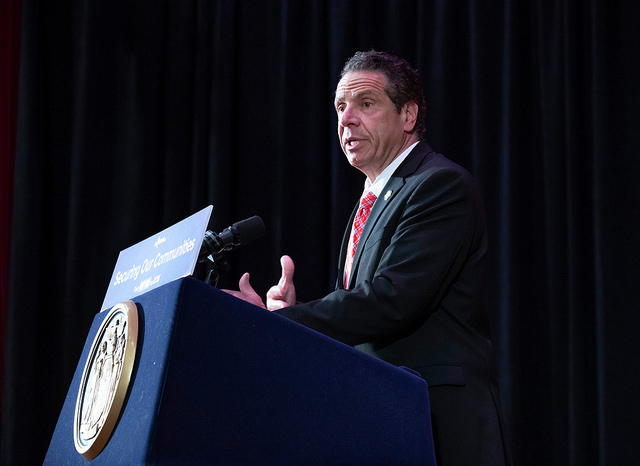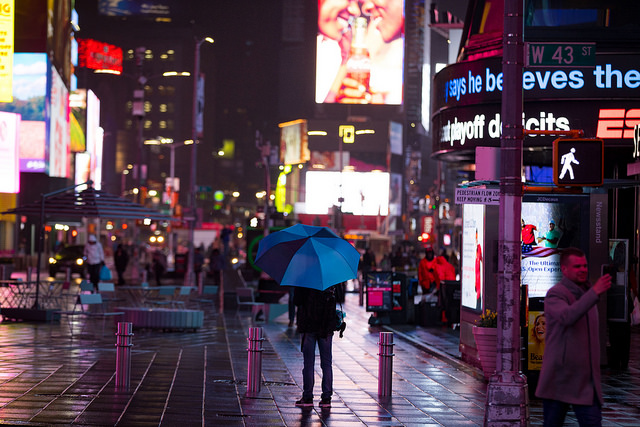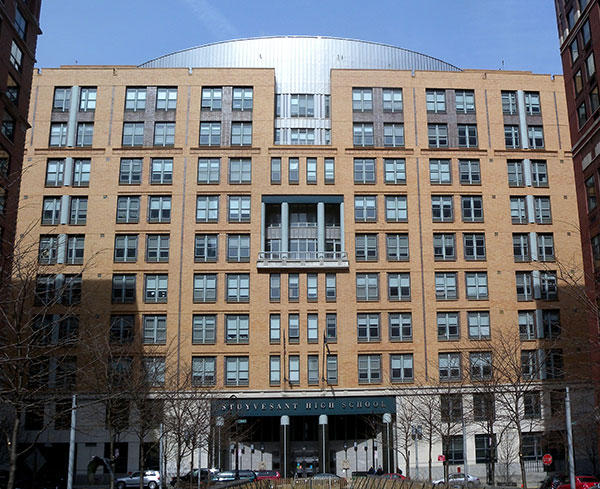Why Cynthia Nixon Will Lose

Gov. Cuomo (photo: Mike Groll/Governor's Office)
One thing is evident when considering the electoral dynamics in New York, and when taking into account recent polling on the gubernatorial race: the path to victory leads through black and Latino communities and Governor Andrew Cuomo has a major leg up.
The most recent Siena College poll indicates that among Latinos and African-Americans Cuomo is winning by significant margins. Among African-Americans polled, the governor receives a whopping 74% of the vote and among Latinos he’s at a significant 69% (support among both groups has increased since Siena’s last poll). Together, black and Latino New Yorkers account for 42% of the entire Democratic primary electorate, according to my calculations. Given these numbers, it is no wonder that Cynthia Nixon is attempting to make inroads into these communities, though seemingly less so in Latino communities than black communities.
Unfortunately for Nixon, the numbers are just not there. While Siena’s polling shows the governor above the 70% mark among communities of color, the reality is that the governor’s support is likely to be higher than that.
Here’s why: Siena’s own numbers indicate that 9% of the statewide overall electorate is African-American and 8% is Latino -- the poll is of likely general election voters, with Democrats asked to weigh in on the primary. But that is a significant undercount of the actual reality in a Democratic primary. According to data provided by L2, a national voter data company, 18% of the New York Democratic primary electorate is Latino and 22% black. So, the 74% support among African-Americans in Siena’s polling, and 69% support among Latinos for Cuomo, will be a bigger deal than anticipated when factoring in actual turnout in the primary.
Beyond the numbers, the governor can lay claim to a host of accomplishments that he can say have positively impacted communities of color. From paid family leave to an increase in the minimum wage; a tuition-free college program to the allocation of $10 million to a defense fund for immigrants facing the Trump administration’s backlash, Cuomo has made a mark for himself particularly among people of color. And the governor a couple of months ago issued an executive order that will help grant the right to vote to most parolees, another constituency dominated by African-Americans and Latinos. Black and Latino communities will ultimately judge whether the governor’s actions have truly benefited them.
When considering these accomplishments, it is no wonder why Governor Cuomo’s favorability remains high among Latino and black New Yorkers. With more than 40% of the primary vote coming from these two key voting blocs, and considering his high favorability ratings among them, Cuomo should move to the general election fairly easily.
***
Eli Valentin is a Democratic consultant and pastor of the Iglesia Evangelica Bautista in New York City. On Twitter @EliValentinNY.
***
Have an op-ed idea or submission for Gotham Gazette? Email This email address is being protected from spambots. You need JavaScript enabled to view it.
Help People with Mental Illness: Make Kendra’s Law Permanent

(photo: Benjamin Kanter/Mayoral Photo Office)
As the state legislative session comes to a close, Governor Andrew Cuomo, Assembly Speaker Carl Heastie, and Assembly Mental Health Committee chair Aileen Gunther have still not made New York’s most effective mental illness law permanent or closed loopholes in it. Their inaction is cruel to people suffering from mental illness and unsafe for the public.
Kendra’s Law allows judges to order a subset of those with the most serious mental illness -- those who have a proven history of arrest, incarceration, hospitalization or violence that was caused by stopping their treatments -- to accept one year of outpatient treatment. Being court ordered to accept treatment, which often includes medications, lowers homelessness, hospitalization, arrest, and incarceration among people with serious mental illness by 70%.
Patients in the court-ordered treatment programs continue to live with their families and friends in their communities, making it less restrictive than the alternatives, inpatient commitment or incarceration. By reducing the use of hospitals and jails it saves taxpayers 50% of the cost of care. Many more people with serious mental illness and a history of hospitalization, arrest, incarceration, or violence should be court-ordered to participate in Kendra’s Law programs.
Kendra’s Law requires the community mental health programs to serve those with serious illnesses who are under court orders, rather than always picking and choosing who they serve. As I documented in Insane Consequences: How the Mental Health Industry Fails the Mentally Ill, trade associations like the New York Association of Psychiatric Rehabilitation Services (NYAPRS) and Mental Health America (MHA) object to it. Some of their members want to continue to receive state funds without any obligation to serve those with the most serious illnesses.
Cuomo, Heastie, and Gunther, have decided to side with these trade associations by refusing to make Kendra’s Law permanent or closing the loopholes in it. That puts patients, the public, and first responders, including police officers, at risk of random acts of violence by those with serious mental illness who go untreated and inhibits efforts to reduce homelessness and needless hospitalizations.
Because as written Kendra’s Law expires every five years, and risks not being renewed, community programs that do support helping those with the most serious mental illness are reluctant to commit to hiring the staff needed to get court orders and provide ongoing monitoring of patients. The monitoring ensures those with serious mental illness under Kendra’s Law are complying with treatment, including their medications.
Heastie and Gunther should ensure the Assembly passes the Kendra’s Law improvement bill proposed by Senator Catharine Young that passed the state Senate, and Governor Cuomo should sign it into law. Kendra’s Law is supported by groups as diverse as the NYS chapter of the National Alliance on Mental Illness and the New York State Association of Chiefs of Police. The bill is even more important during a time that the state is continuing its relentless push to close state psychiatric hospitals, the last refuge for many of those with the most serious mental illness.
In Governor Cuomo’s State of the State speech, he talked compassionately about those with mental illness who are homeless. “Leaving a sick person to fend for themselves is not progressive, charitable, ethical or legal...It is our obligation as a caring people, a compassionate society, to reach out and provide whatever social services or address whatever needs the individuals presents." He went on to ask localities to “tell us what law stops them from helping mentally ill street homeless and we will change the law this session."
Kendra’s Law is that law that needs changing. It needs loopholes closed and permanence. Cuomo, Heastie, and Gunther should do that now, before the next tragedy.
***
DJ Jaffe is author of Insane Consequences: How the Mental Health Industry Fails the Mentally Ill and Executive Director of Mental Illness Policy Org, a non-partisan think-tank on mental illness policy.
***
Have an op-ed idea or submission for Gotham Gazette? Email This email address is being protected from spambots. You need JavaScript enabled to view it.
What Stuyvesant High School Was For Me

Stuyvesant High School (photo: Jim Henderson via Wikipedia)
When I graduated from Stuyvesant High School in June of 2001, I remember feeling sad to be moving on from my friends and excited to be moving on to college. But I also remember an overwhelming sense of relief that I would no longer have to deal with the tests that formed the backbone of the Stuyvesant High School experience.
The tests didn’t start at the end of the first semester or even during midterms freshman year. They did not even start on the day that I made the trip down to Battery Park to take the “Stuy test.” Rather, they started toward the end of middle school, spending Saturday mornings in a hotel conference room in midtown Manhattan, taking a prep course run by a Stuyvesant math teacher (who, when I was a sophomore, would give me the lowest grade of my high school career). I remember that many of us wore our soccer uniforms and cleats to class because we had to hurry off to games immediately afterwards.
By this time I had been subjected to plenty of high-stakes exams: pre-school interviews, citywide exams, a fifth grade full of tests and interviews to get into well-regarded public middle schools, and, even after I had started attending one such school, the Hunter test, on which I did not come remotely close to earning the admission score. I understood some of those tests to be more important than others, but none carried the weight of the ones related to Stuyvesant. The implication, starting with preparations for the SHSAT, and continuing at a pace of six or more exams per semester during my time at Stuyvesant and additionally highlighted by the SAT, was that how I performed on each exam was going to impact the rest of my life.
My parents did not pressure me to get into Stuyvesant or seem to care about where I went to college (though it was always understood I would go). They did pressure me to do the homework the prep course assigned, and I recall that I did it. I scored a 560 on the exam -- the cutoff was 559 -- and was excited to be accepted as, technically speaking, the dumbest kid in school. I called a close friend who told me he had missed getting in by one question. He would be going to Bronx Science. Even though we only lived a few blocks away from each other, we drifted apart after that.
The pressure was entirely driven by the culture surrounding Stuyvesant. Other than the occasional creative writing course or class led by an outside-the-box thinking history teacher, Stuyvesant was all about tests. The midterms and finals were inflexible and merciless. Scantrons were everywhere. “What did you get on the test?” was a frequent question, one that had to be asked with a level of tact that high school kids are seldom capable of.
Even though I was, relative to my classmates, an unmotivated, average student, content to get Bs and take “remedial” Spanish and math (which at Stuyvesant meant taking ninth-grade Spanish as a ninth-grader and not taking calculus), I would sometimes wake up in the middle of the night and scribble math equations on a piece of paper next to my bed. At my mom’s advice, I took to sleeping with textbooks underneath my pillow the night before tests, hoping to learn just a little more through osmosis.
At the end of one semester there was a rash of episodes involving fire alarms getting pulled and the school being unnecessarily evacuated. It was rumored that they caught the culprit by identifying a single student who had an exam scheduled on each of the days an evacuation occurred. Students whispered that we could not access the patio outside the fifth floor cafeteria because the administration was afraid if we were allowed on it there would be suicides. It was said we were not given class rankings for the same reason.
Cheating, which relied both on old-fashioned methods and newfangled technology like cell phones and digital cameras, was rampant. Some kids cheated to get the grades they felt they needed and some kids cheated just to get by. Some kids just disappeared, presumably moving on to schools where things were a little less intense. I remember crying in a taxi on the way home from college night as a sophomore because it was clear I could not even expect to get into “Wash U. in St. Louis.”
Exams aside, there was a lot of fun to be had at Stuy. I wrote for the sports section of the school newspaper. A review of the yearbook tells me there were more than 90 clubs, including something called “The Real,” devoted to “underground hip-hop music,” that I was the president of -- it is my recollection that we had no budget or formal meetings. I played backup tight end on the football team, which I am not sure I could have done at another school. Significantly, in my experience the football team was one of the few places at Stuyvesant where Asian, black, Hispanic, and white students really spent time together (the cheerleading team was a similarly integrated group).
I can still remember all the different parts of the school where students of particular races congregated almost exclusively and I suspect that my classmates can as well. On the second floor where the main entrance and exit was located, there was a “senior bar” -- basically a waist-high counter surrounded by lockers -- that at the time I would have said was the epicenter of the social life of the school but I now realize was overwhelmingly white. There was another “bar” that was widely referred to as the “Asian bar” on the sixth floor. I recall that there was an area behind the escalators on the fifth floor where African-American students hung out.
The exact demographic makeup of the school at the time is difficult to find online, but as I recall, Asian students made up about half the school, with white students making up most of the other half. As now, the percentage of black and Hispanic students was well below 10%. I am sure that Stuyvesant has changed in many ways since I left, but in some important ones, it has not.
Like most alums, it is through my perspective from and since my time at Stuyvesant that I view the ongoing debate about how -- and whether -- specialized high school admissions should be reformed. Stuyvesant needs to be more diverse and it is not entirely clear how best to make that happen.
What I find missing from the debate is a discussion about how the “Stuy test” and the Stuyvesant experience are linked. If students are not going to be admitted based on their ability to excel on a single, high-pressure exam, they should not be evaluated primarily based on high-pressure exams. It seems likely that a student body admitted to Stuyvesant based on criteria other than the SHSAT would benefit from a reduced emphasis on testing. It may even be that all students, including current Stuyvesant students, would benefit from a reduced emphasis on testing.
At the same time, the iteration of Stuyvesant I attended left me very well prepared for college and law school. I feel strongly that I was always going to be an average student in high school. At an underperforming school, that might mean barely graduating. At Stuyvesant, that meant a B average and a partial scholarship to Lehigh University. Many New York City students would benefit from the education I received, regardless of how they are admitted to the school or how painful it might be while they are there.
***
Jonathan Fishner is a graduate of Stuyvesant High School, class of 2001, and an attorney. His opinions are his own.
***
Have an op-ed idea or submission for Gotham Gazette? Email This email address is being protected from spambots. You need JavaScript enabled to view it.




